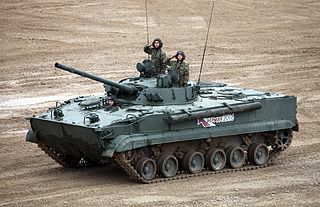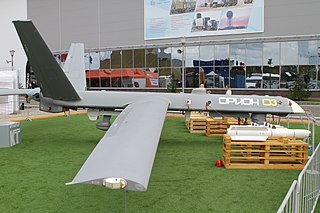An autonomous robot is a robot that acts without recourse to human control. Historic examples include space probes. Modern examples include self-driving vacuums and self-driving cars.

The Merkava is a series of main battle tanks (MBT) used by the Israel Defense Forces (IDF) and the backbone of the IDF's Armored Corps. Current iterations of this tank are considered broadly equivalent to the capabilities of the M1 Abrams, Leopard 2 and the Challenger 2. The current iteration of this vehicle also shares the same MTU EuroPowerPack powerplant as a number of other MBT platforms.

The BMP-3 is a Soviet and Russian infantry fighting vehicle, successor to the BMP-1 and BMP-2. The abbreviation BMP stands for Boevaya Mashina Pekhoty.

The 9M133 Kornet is a Russian man-portable anti-tank guided missile (ATGM) intended for use against main battle tanks. It was first introduced into service with the Russian army in 1998.

Power projection in international relations is the capacity of a state to deploy and sustain forces outside its territory. The ability of a state to project its power into an area may serve as an effective diplomatic lever, influencing the decision-making processes and acting as a potential deterrent on other states' behavior.

The M242 Bushmaster chain gun is a 25 mm (25×137mm) single-barrel chain-driven autocannon. It is used extensively by the U.S. military, such as in the Bradley fighting vehicle, as well as by other NATO members and some other nations in ground combat vehicles and various watercraft. Hughes Helicopters in Culver City, California, was the original designer and manufacturer. As of 2019, Northrop Grumman Innovation Systems produces the gun.

An unmanned ground vehicle (UGV) is a vehicle that operates while in contact with the ground without an onboard human presence. UGVs can be used for many applications where it is inconvenient, dangerous, expensive, or impossible to use an onboard human operator. Typically, the vehicle has sensors to observe the environment, and autonomously controls its behavior or uses a remote human operator to control the vehicle via teleoperation.

JSC Rosoboronexport is the sole state intermediary agency for Russia's exports/imports of defense-related and dual use products, technologies and services. The Rosoboronexport Federal State Unitary Enterprise (FSUE) was set up in 2000 by a Decree of the President of Russia and is charged with implementation of the policy of the State in the area of military-technical cooperation between Russia and foreign countries. In 2007, the enterprise was re-registered as Rosoboronexport Open joint-stock company (OJSC). In 2011, Rostekhnologii non-profit state corporation acquired 100% of Rosoboronexport OJSC.

The history of unmanned combat aerial vehicles (UCAVs) is closely tied to the general history of unmanned aerial vehicles (UAVs). While the technology dates back at least as far as the 1940s, common usage in live operations came in the 2000s. UCAVs have now become an important part of modern warfare, including in the Syrian civil war, the 2020 Nagorno-Karabakh war and during the 2022 Russian invasion of Ukraine.

The BMPT "Terminator" is an armored fighting vehicle (AFV), designed and manufactured by the Russian company Uralvagonzavod. This vehicle was designed for supporting tanks and other AFVs in urban areas. The BMPT is unofficially named the "Terminator" by the manufacturers. It is heavily armed and armored to survive in urban combat. The AFV is armed with four 9M120 Ataka missile launchers, two 30 mm 2A42 autocannons, two AG-17D grenade launchers, and one coaxial 7.62 mm PKTM machine gun.

TOS-1 Buratino is a Soviet 220 mm 30-barrel or 24-barrel multiple rocket launcher capable of using thermobaric warheads, mounted on a T-72 / T-90 tank chassis. TOS-1 was designed to attack enemy fortified positions and lightly armored vehicles and transports, particularly in open terrain. The system’s first combat tests took place in 1988 and 1989 in the Panjshir Valley during the Soviet–Afghan War. The TOS-1 was shown for the first time in public in 1999 in Omsk.

The Shipunov 2A42 is a Soviet/Russian 30 mm autocannon. It is built by the Tulamashzavod Joint Stock Company and named after A. G. Shipunov.
List of abbreviations, acronyms and initials related to military subjects such as modern armour, artillery, infantry, and weapons, along with their definitions.

The M2 Bradley, or Bradley IFV, is an American infantry fighting vehicle that is a member of the Bradley Fighting Vehicle family. It is manufactured by BAE Systems Land & Armaments.

The Tigr is a Russian 4×4 multipurpose all-terrain infantry mobility vehicle manufactured by Military Industrial Company, first delivered to the Russian Army in 2006.

The Type 08 is a family of eight-wheeled amphibious, modular armored vehicle developed by Norinco for infantry fire support, battlefield logistics, and quick reaction operations. Developed in the early 2000s, the modern Chinese vehicle family were produced for more than 6000 hulls and widely deployed by the People's Liberation Army Ground Force and People's Liberation Army Marine Corps.

The Engin Blindé de Reconnaissance et de Combat Jaguar or EBRC Jaguar is a six-wheel armoured fighting vehicle developed and manufactured by Nexter, Arquus and Thales. Intended to succeed three reconnaissance and/or fire support vehicles in French service, namely the AMX-10 RC, ERC 90 Sagaie and VAB HOT, the vehicle entered service in 2022 after twelve years of development.

The Kronshtadt Orion is a family of Russian unmanned aerial vehicles (UAV) developed by Kronstadt Group. There are several variants of the drone, both for Russia's domestic and export market.

Zapad 2021 was a joint strategic exercise between the armed forces of the Russian Federation and Belarus, which took place from 10 to 15 September 2021. According to the Ministry of Defence of the Russian Federation, approximately 200,000 military personnel, up to 760 pieces of equipment, and 15 ships participated in the exercises.




















